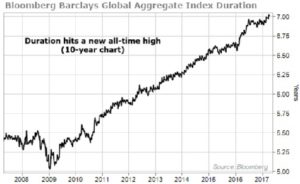Since 2008, central banks around the world have set their shortest-term interest rates at, or below, zero. In order to provide savers or investors with a higher return, money managers have slowly crept further out in time on the investment-yield curve. For example, while a bond fund previously invested in 2-year bonds , they may now be investing in 5-year bonds to keep their dividend rate competitive. The risk of a 5-year bond is significantly greater than a 2-year bond, and if you’re not paying attention, you may not know that your money manager has been putting your money at far greater interest-rate risk.
The mathematical bond term for time is, “duration.” This refers to the number of years to recover the cost of a current bond purchase. (Calculated by the net-present value of all the bond coupon and principal payments.) This way, the length of bond-like investments can be compared with a single number, their duration. As you can see in the chart, bond fund duration has been continually getting longer since 2009. This longer duration adds enormous risk to any money in funds that are buying longer-dated bonds to increase their yield.
To avoid this duration creep, you can either purchase individual short-term bonds and hold them until maturity, or buy a fund to do this for you. To make it easy for investors, there are now bond funds that target a particular date. Another bond-fund candidate that you may want to consider is RiverPark Strategic Income Fund, ticker symbol, “RSIVX.” This is a 4-year-old bond fund run by an expert on short-term high-yield bonds which currently has a yield over 6%. The fund has minimal exposure to rising rates because of short duration, pays out monthly dividends, and a long track record of buying bonds that always payout in full. You can learn more about this fund at http://www.riverparkfunds.com/Funds/StrategicIncome/Overview.aspx
As always, you must perform your own due diligence to determine if these may be an appropriate fit for your portfolio. If you decide that they are something to invest in, never invest more than 5% of your portfolio into any one alternative strategy; such as this fund.

